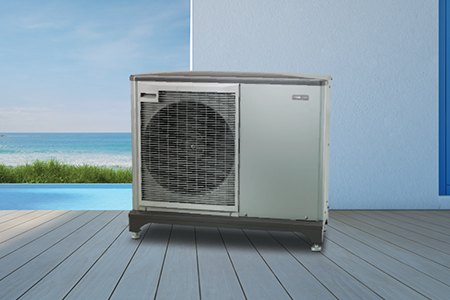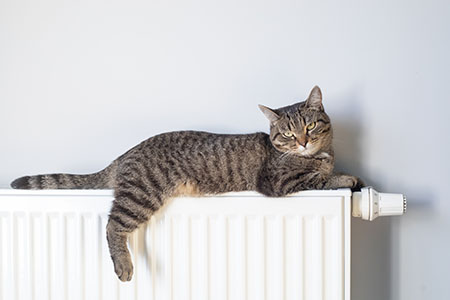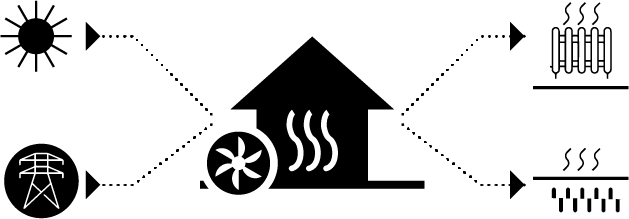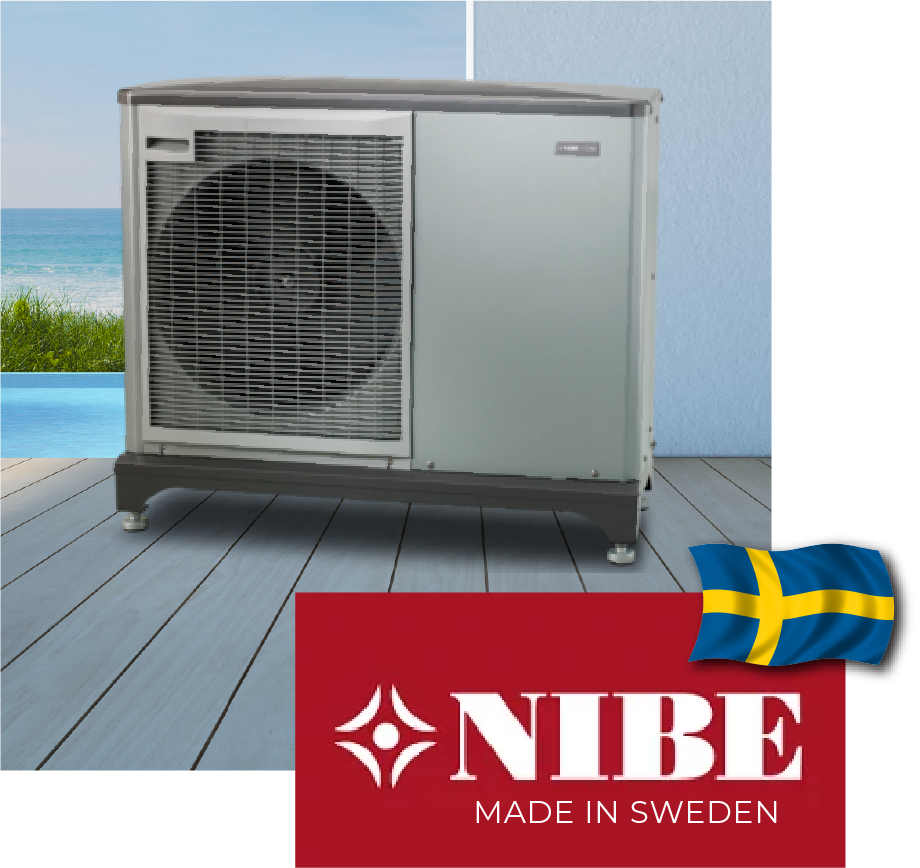Telephone: 01269 500388 email: info@celticgreenenergy.co.uk
Heat pumps are an eco-friendly and low-carbon heating system, significantly more efficient than traditional boilers. Instead of burning fuels like gas or oil, they operate using electricity and a refrigerant to transfer heat from the outdoors into your home for both heating rooms and providing hot water. This method offers a sustainable and cost-effective solution for various settings, including homes, businesses, and industries, by harnessing heat from the outside air, even in temperatures as low as -25 degrees Celsius.
To help with the initial investment, the government frequently provides grants to reduce upfront costs. Heat pumps come in different types to accommodate individual needs. The most common for households are air source heat pumps (ASHPs), which resemble outdoor air conditioning units and connect to the existing heating system. Alternatively, ground source heat pumps (GSHPs) extract thermal energy from beneath the ground and integrate with the heating setup, particularly suitable for properties with gardens or ample outdoor space. For properties without radiators or underfloor heating, air-to-air heat pumps offer a solution, often found in smaller homes like flats or park homes.
The operational costs of heat pumps vary based on factors related to the heating system and the property itself.






We source our Air source Heat pumps from the world’s leading manufacturer, Swedish based NIBE who offer a comprehensive 10 year warranty on their products.
Although there are other less expensive brands available, we choose NIBE for their superior performance. Built and tested in a harsh Scandinavian climate, they manufacture outstanding build quality that surpass our needs for the worst of British climate. The NIBE F2040 is an intelligent and compact inverter controlled air source heat pump that provides optimum savings as the heat pump automatically adapts to your home’s output requirements all year round. The heat pump works down to an outdoor temperature of –20°C and at the same time supplies up to 58°C in supply line temperature.
An Air Source Heat Pump uses an electric powered compressor that forces cold air through a heat exchanger. Using compressed refrigerant the pressure of the refrigerant gas increases along with the temperature. When the pressure decreases, the temperature decreases. This relationship between pressure and temperature is the key to how a heat pump works. As the refrigerant’s heat is transferred through the heat exchanger, it cools down. As the refrigerant then expands, it cools down even further and is now cold enough to absorb more heat from outside to begin the process again. The residual heat delivered to the heat exchanger is then used to heat your home. This is normally done through a conventional central heating system – but it could also be done using warm air in either an Air-to-Air heat pump or an Exhaust Air Heat Pump.
The compressor in a heat pump works harder when there is a larger temperature difference between the outside source temperature and the water temperature needed in your radiators or underfloor heating. The less the compressor needs to work, the less electricity the heat pump uses. Whilst we are unable to control the outdoor source temperature, it is possible to design a heating systems that uses low temperature water indoors where the heat pump can use less electricity and still heat your home comfortably. This is achieved by using radiators with a larger surface area or underfloor heating. More heat can be delivered into the room without increasing the water temperature as well as running the heating system for longer to provide a continuous ambient heat.
Conversely, if you have radiators with a smaller surface area, the heat pump will have to run at a higher temperature. This will result in the compressor working harder to deliver the same amount of heat as it would with larger radiators, or if it had a longer time to run. When the compressor works harder, it uses more electricity, which makes the system less efficient and more expensive to run. The aim of a well-designed system is to reduce the heating water temperature as much as possible. The closer the required temperature is to the source temperature (ie the outside air or ground temperature), the more efficient the heat pump will be, and therefore the lower the running costs. Heat pumps are more efficient than other heating systems because the amount of heat they produce is more than the amount of electricity they use.
The amount of heat produced for every unit of electricity used is known as the Coefficient of Performance (CoP). So, if a heat pump has a CoP of 3.0, then it will give out three units of heat for every unit of electricity consumed. Every heat pump has a published datasheet telling you what its measured CoP is. The CoP is measured at a single point in time, under specific test conditions. However, in real life the heat pump experiences seasonal temperature variations throughout the year, so the CoP is not always a true reflection of the efficiency. Instead, the Seasonal Coefficient of Performance (SCoP) or Seasonal Performance Factor (SPF) is used to show the efficiency of the heat pump across a whole year. To help advise you better, our surveyors will be able provide an illustration of the SPF for an ideal system for your home. This calculation will demonstrate how the heat pump should perform given the average temperatures at your location and other factors such as the size of your radiators. The SPF will give you a better indication of what to expect in terms of running costs and efficiency than the CoP figure.
Having an efficient heating system running on a low carbon fuel is one of the most important steps you can take to reduce your fuel bills and your carbon dioxide emissions. In a typical household, over half of the fuel bills are spent on heating and hot water. An efficient heating system that you can control easily can help reduce your fuel bills and reduce your carbon emissions. Whilst electricity is required to power the Air Source Heat Pump, it uses less energy than the quantity of heat is produced. However, the quantity of electricity consumed versus the volume of heat generated will depend on the external source temperature and the output temperature required. This will constantly change throughout the year as outside temperatures change with the seasons.
This will affect your energy bill will depend on several factors, including:
Air Source Heat Pumps offer the lowest carbon form of heating available. They work best with a purpose designed central heating systems such as large radiators or underfloor heating. For properties fitted with mains gas or oil boilers and conventional central heating radiators, heat pumps may likely to be slightly more expensive to run. However, as utility and fuel prices fluctuate, we expect that heat pumps will soon become the more economic option. For details on the fitting of a purpose designed central heating system, please check out our section on Underfloor heating.
Heat Pump systems are easy to use and virtually maintenance free. We do however recommend an annual service check to ensure optimum performance and efficiency. With regular scheduled maintenance, you can expect a heat pump to operate for 15 years or more. All our Heat Pump systems come with a 10 year warranty through Quality Assured National Warranties (QANW). Typical service checks include a visual inspection of the water pump, external pipes, fittings and electronics. Ground source heat pumps may also occasionally need to be re-pressurised or have the quality of the antifreeze checked, which can be done every 2-3 years.
If we are to reach the net zero carbon emissions target set by the UK Government, we will need to reduce the carbon emissions from heating our homes by 95% over the next 30 years. The average household generated 2,690kg of carbon dioxide (CO2) from space heating and hot water heating in 2020. By 2050, we need to reduce this to just 140kg per household.
The use of Heat Source Pumps will help to dramatically cut emissions and achieve this net zero carbon goal.
If you would like to discuss your energy requirements, drop us a line or give us a call and we will arrange for an onsite appointment with our Commercial Sales Director.

We will discuss and agree your requirements then prepare a detailed cost illustration outlining the most effective energy solutions and expected outcome.

On agreement of the proposal, we will plan and manage the project including all necessary paperwork, Building Control and District Network Operator (DNO) requirements for you.

Our team will plan and arrange for our engineers to install your new system and provide you with an update on progress including regular customer service updates.

When the installation is completed, you will receive a comprehensive handover pack including all compliance and warranty certificates and operating instructions.